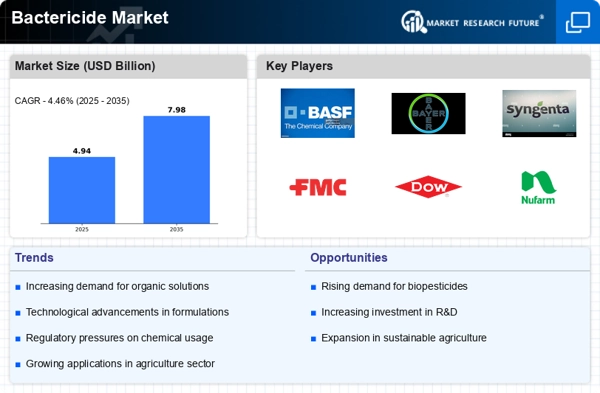The Bactericide Market is currently characterized by a dynamic competitive landscape, driven by increasing agricultural demands and the necessity for sustainable pest management solutions. Key players such as BASF SE (Germany), Bayer AG (Germany), and Syngenta AG (Switzerland) are strategically positioned to leverage innovation and regional expansion to enhance their market presence. BASF SE (Germany) focuses on developing advanced formulations that improve efficacy while minimizing environmental impact, whereas Bayer AG (Germany) emphasizes digital transformation in agriculture, integrating data analytics to optimize product performance. Syngenta AG (Switzerland) appears to be concentrating on strategic partnerships to bolster its research capabilities, thereby enhancing its product portfolio and market reach. Collectively, these strategies contribute to a competitive environment that is increasingly oriented towards sustainability and technological advancement.
In terms of business tactics, companies are localizing manufacturing to reduce costs and improve supply chain efficiency. The Bactericide Market is moderately fragmented, with several key players exerting influence over various regional markets. This fragmentation allows for niche players to thrive, while larger corporations capitalize on economies of scale and extensive distribution networks. The collective influence of these key players shapes market dynamics, as they compete not only on product efficacy but also on sustainability practices and technological integration.
In August 2025, Bayer AG (Germany) announced a significant partnership with a leading agri-tech firm to develop AI-driven solutions for pest management. This strategic move is likely to enhance Bayer's capabilities in precision agriculture, allowing farmers to make data-driven decisions that optimize the use of bactericides. The integration of AI into their product offerings may position Bayer as a leader in innovative pest management solutions, potentially reshaping competitive dynamics in the market.
In September 2025, Syngenta AG (Switzerland) launched a new bactericide product that utilizes a novel active ingredient derived from natural sources. This introduction not only aligns with the growing consumer demand for sustainable agricultural practices but also reinforces Syngenta's commitment to innovation. The strategic importance of this launch lies in its potential to capture market share among environmentally conscious farmers, thereby enhancing Syngenta's competitive edge.
In July 2025, BASF SE (Germany) expanded its production facility in Brazil, aiming to increase its output of bactericides tailored for the South American market. This expansion reflects BASF's strategy to localize production and respond to regional agricultural needs more effectively. By enhancing its manufacturing capabilities, BASF is likely to improve its supply chain reliability and reduce lead times, which are critical factors in maintaining competitiveness in the Bactericide Market.
As of October 2025, current trends in the Bactericide Market indicate a pronounced shift towards digitalization, sustainability, and the integration of artificial intelligence. Strategic alliances among key players are increasingly shaping the competitive landscape, fostering innovation and collaborative research efforts. Looking ahead, it appears that competitive differentiation will evolve from traditional price-based competition to a focus on technological advancements, sustainable practices, and supply chain resilience. This shift may redefine how companies position themselves in the market, emphasizing the importance of innovation and reliability in meeting the demands of modern agriculture.


















Leave a Comment